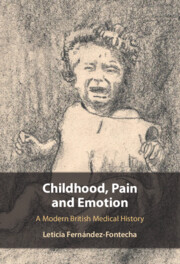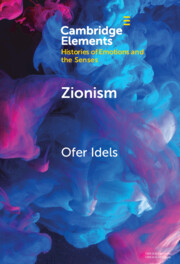Refine search
Actions for selected content:
39 results
The politics of pity in Italian views of defeated Germany
-
- Journal:
- Modern Italy , First View
- Published online by Cambridge University Press:
- 15 September 2025, pp. 1-18
-
- Article
-
- You have access
- Open access
- HTML
- Export citation
Conclusion
-
- Book:
- Childhood, Pain and Emotion
- Published online:
- 21 March 2025
- Print publication:
- 03 April 2025, pp 197-203
-
- Chapter
- Export citation
Introduction
-
- Book:
- Childhood, Pain and Emotion
- Published online:
- 21 March 2025
- Print publication:
- 03 April 2025, pp 1-20
-
- Chapter
- Export citation

Childhood, Pain and Emotion
- A Modern British Medical History
-
- Published online:
- 21 March 2025
- Print publication:
- 03 April 2025
16 - Approaching Ottoman Cultural History
- from Part II - Perspectives and Methods
-
-
- Book:
- The Cambridge Companion to Ottoman History
- Published online:
- 31 May 2025
- Print publication:
- 20 March 2025, pp 224-235
-
- Chapter
- Export citation
7 - To Be Happy Doing What You Want
- from Scene I - Hieronymus Sebastian Schutze and Hans Devil
-
- Book:
- The War People
- Published online:
- 19 December 2024
- Print publication:
- 19 December 2024, pp 118-134
-
- Chapter
- Export citation

Zionism
- Emotions, Language and Experience
-
- Published online:
- 22 November 2024
- Print publication:
- 12 December 2024
-
- Element
- Export citation
Conclusion: The Fate of Feeling
-
- Book:
- Romantic Music Aesthetics
- Published online:
- 22 November 2024
- Print publication:
- 21 November 2024, pp 219-236
-
- Chapter
- Export citation
Introduction
-
- Book:
- Romantic Music Aesthetics
- Published online:
- 22 November 2024
- Print publication:
- 21 November 2024, pp 1-25
-
- Chapter
-
- You have access
- HTML
- Export citation
Feeling the rules: Historical and contemporary perspectives on emotional norms and social distinction
-
- Journal:
- Social Science History / Volume 48 / Issue 4 / Winter 2024
- Published online by Cambridge University Press:
- 11 December 2024, pp. 603-619
- Print publication:
- Winter 2024
-
- Article
-
- You have access
- Open access
- HTML
- Export citation
Pride, prejudice, and working-class furniture – A history of Gelsenkirchener Barock
-
- Journal:
- Social Science History / Volume 48 / Issue 4 / Winter 2024
- Published online by Cambridge University Press:
- 20 December 2024, pp. 723-749
- Print publication:
- Winter 2024
-
- Article
-
- You have access
- Open access
- HTML
- Export citation
Ugly ambition: “Sportsgirls” and the German press in the 1920s
-
- Journal:
- Social Science History / Volume 48 / Issue 4 / Winter 2024
- Published online by Cambridge University Press:
- 09 October 2024, pp. 751-775
- Print publication:
- Winter 2024
-
- Article
-
- You have access
- Open access
- HTML
- Export citation
The Perils of Privacy and Passivity: Antidemocratic, Racist, and Antisemitic Sentiments in Postwar West Germany
-
- Journal:
- Central European History / Volume 58 / Issue 1 / March 2025
- Published online by Cambridge University Press:
- 30 September 2024, pp. 1-24
- Print publication:
- March 2025
-
- Article
-
- You have access
- Open access
- HTML
- Export citation
18 - Sexuality and Emotion
-
-
- Book:
- The Cambridge World History of Sexualities
- Published online:
- 26 April 2024
- Print publication:
- 16 May 2024, pp 388-409
-
- Chapter
- Export citation
Chapter 7 - Neo-Latin
-
-
- Book:
- The Cambridge Critical Guide to Latin Literature
- Published online:
- 04 January 2024
- Print publication:
- 18 January 2024, pp 334-394
-
- Chapter
- Export citation
Chapter 2 - Medieval Affect, The Book of Margery Kempe, and Medical Treatments of the Embodied Soul
- from Part I - Origins: Histories
-
-
- Book:
- Literature and Medicine
- Published online:
- 17 January 2024
- Print publication:
- 18 January 2024, pp 39-52
-
- Chapter
- Export citation
How Jean-Baptiste Charcot came to embrace fear but not anger. Emotions of polar exploration and their communication to the public in the 1900s
-
- Journal:
- Polar Record / Volume 60 / 2024
- Published online by Cambridge University Press:
- 10 January 2024, e3
-
- Article
-
- You have access
- Open access
- HTML
- Export citation
2 - Writing Family Together across Imperial Distances
-
- Book:
- Working-Class Raj
- Published online:
- 20 October 2023
- Print publication:
- 02 November 2023, pp 49-69
-
- Chapter
- Export citation
Introduction
-
- Book:
- The Power of Emotions
- Published online:
- 14 July 2023
- Print publication:
- 17 August 2023, pp 1-19
-
- Chapter
- Export citation

Memory and Affect in Shakespeare's England
-
- Published online:
- 07 June 2023
- Print publication:
- 27 July 2023
